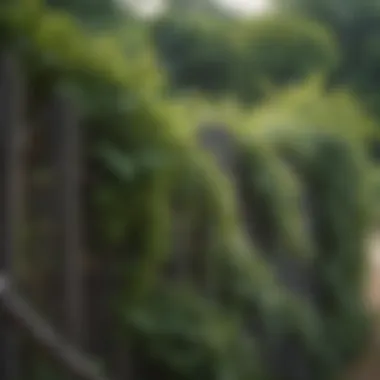Effective Strategies to Eradicate Kudzu: A Comprehensive Guide


Intro
Kudzu, a plant native to Asia, has become a notorious invasive species in the United States. Its rapid growth and aggressive nature allow it to dominate landscapes and choke out native flora. Understanding effective strategies to eradicate kudzu is crucial for the preservation of local ecosystems. This guide presents comprehensive approaches to tackling this pervasive issue, integrating both chemical and non-chemical strategies.
Plant Overview
Common Names
Kudzu is commonly referred to as kudzu vine, Japanese arrowroot, or foot-a-night. These names reflect its quick growth and ability to cover structures and natural scenery almost overnight.
Scientific Classification
- Kingdom: Plantae
- Phylum: Angiosperms
- Class: Eudicots
- Order: Fabales
- Family: Fabaceae
- Genus: Pueraria
- Species: Pueraria lobata
Geographic Range
Kudzu is found mostly in the southeastern part of the United States. It thrives in warm, humid climates and can be seen widely from Virginia to Texas. Outside the U.S., it is also prevalent in areas of Asia, particularly in Japan and China.
Impact on the Ecosystem
Kudzu affects local ecosystems significantly. It competes aggressively with native plant species, leading to diminished biodiversity. Furthermore, it impacts wildlife by altering habitat conditions and food availability.
Strategies for Control
Many methods exist for controlling kudzu. They can be broadly categorized into mechanical, chemical, and biological strategies. Each method has its merits and should be considered based on site-specific factors and environmental considerations.
End
Understanding the biology and impacts of kudzu is key to developing effective removal strategies. A combination of mechanical and biological methods, supported by targeted chemical controls, forms the foundation of an effective eradication plan. Through informed and diligent efforts, it is possible to mitigate kudzu's invasiveness and restore balance to affected ecosystems.
Understanding Kudzu
Understanding kudzu is crucial in combating its spread and mitigating its harmful effects. This section provides insights into various aspects of the plant, such as its history, biological characteristics, and ecological impact. Recognizing these factors is the first step toward effective management strategies. The knowledge gained here is imperative for those who live in areas affected by this invasive species.
The History of Kudzu in America
Kudzu, originally from Asia, was introduced to the United States in the late 1800s. The primary aim was to control soil erosion in Southern states. Over time, its aggressive growth became problematic. By the mid-20th century, kudzu was widely recognized as an invasive species. Its rapid spread in the Southeast is often attributed to favorable growing conditions and a lack of natural predators. Today, kudzu covers millions of acres, dominating local landscapes and overshadowing native flora.
Biology and Growth Patterns
Kudzu is a perennial vine capable of growing up to one foot per day under optimal conditions. Its growth is fueled by a robust root system that can reach deep into the soil. The plant thrives in various habitats, including forests, fields, and roadsides. Its ability to climb over trees and shrubs allows it to access sunlight, further enhancing its growth. Recognizing its growth patterns is essential for dealing with infestations effectively. The plant's capacity to reproduce through seeds and vegetative means makes it particularly resilient.
Ecological Effects of Kudzu
Kudzu poses significant ecological concerns. For starters, it outcompetes native vegetation for sunlight and nutrients. This leads to decreased biodiversity in affected areas. Many native species suffer as they cannot compete with the rapid growth of kudzu. Additionally, its dense coverage can alter local habitats, impacting wildlife populations that rely on native plants. The consequences ripple through ecosystems, affecting food webs and overall ecological balance. Understanding these effects underlines the urgency for effective management of this invasive species.
“Kudzu is often referred to as 'the vine that ate the South,' highlighting its aggressive nature and ecological impact.”
Identifying Kudzu Infestations
Identifying kudzu infestations is a crucial step in managing this invasive species. Early detection allows for timely interventions, which can significantly reduce the plant's spread and minimize ecological impact. Knowing how to recognize kudzu growth and chart its locations is essential for anyone involved in landscape management, conservation efforts, or those simply interested in preserving local ecosystems.
Signs of Kudzu Presence
Understanding the signs that indicate kudzu's presence can help in effective identification. This invasive plant is known for its rapid growth and distinctive features:
- Leaf Structure: Kudzu leaves are large, usually consisting of three leaflets. They are heart-shaped and can reach up to six inches across.
- Vines and Climbing Behavior: Mature kudzu can grow as much as a foot in a single day, using its strong vines to climb trees, fences, and buildings. These vines can become quite thick and often smother native vegetation.
- Flowers and Seed Pods: Kudzu produces clusters of fragrant purple flowers in late summer. These eventually develop into seed pods, which can further spread the plant if not properly managed.
- Signs of Damage: Look for areas where native plants are struggling to survive. Kudzu often grows in dense patches, creating bare areas beneath its canopy as it blocks sunlight from reaching other plants.


Recognizing these signs is the first step toward effective eradicition efforts.
Mapping Infestations
Mapping infestations is an essential part of controlling kudzu propagation. Maintaining an accurate record of locations where kudzu is growing aids in developing targeted management strategies. Here are some critical components to consider when mapping:
- Use of Technology: Leveraging technology like Geographic Information Systems (GIS) enables more precise tracking of kudzu locations. Mobile apps can also assist with recording sites in real-time.
- Monitoring Growth Over Time: Regularly updating maps to reflect changing growth conditions is important. This allows for adjustments in control efforts as required.
- Community Involvement: Engaging local communities in mapping efforts enhances the resources available for monitoring. People can share observations which can be compiled into comprehensive data that benefits everyone.
- Creating Detailed Records: Documenting information such as the extent of infestation and proximity to sensitive ecosystems helps prioritize areas requiring immediate attention.
Accurate mapping offers a clear understanding of the scope of the problem, which is essential for developing a strategic eradication plan.
Effective management of kudzu infestations relies heavily on early identification and thorough mapping. These practices are pivotal in ensuring the sustained health of local ecosystems.
Chemical Control Methods
Chemical control methods are a significant aspect of managing kudzu infestations. Kudzu is known for its rapid growth and ability to dominate ecosystems, making effective control crucial. These methods often involve the use of herbicides, which can provide effective and immediate results when applied correctly. Herbecides target the plant while often leaving surrounding flora and fauna unharmed, if used with caution. However, it is essential to follow guidelines for use to prevent environmental harm and ensure safety.
Herbicides: Types and Application
There are various types of herbicides that can be effective for controlling kudzu. Systemic herbicides, such as glyphosate, work by being absorbed into the plant's system, eventually killing it from the inside out. Another effective option is triclopyr, which is specifically formulated for woody plants and can prevent kudzu from establishing itself further in disturbed areas.
When applying herbicides, timing is key. The best period for application is late summer or early fall when the kudzu plants are actively transporting nutrients to their roots. This promotes the absorption of the herbicide, maximizing effectiveness. Proper application techniques, such as spot treatments, can minimize the impact on neighboring vegetation.
Key considerations when using herbicides:
- Follow Label Directions: This ensures safety and effectiveness.
- Optimal Conditions: Apply on dry, calm days to reduce drift.
- Target Specific Areas: Be precise to minimize collateral damage.
Safety Precautions and Environmental Impact
Using chemical control methods does raise concerns about safety and environmental impact. To mitigate risks, protective gear such as gloves and masks should be worn during application. It is also advisable to keep pets and children away from treated areas until herbicides have dried completely.
The impact of using herbicides extends to local ecosystems. While effective, their use may affect non-target plant species and insects. Therefore, it is crucial to monitor the treated areas for any adverse effects. Understanding local regulations regarding herbicides ensures compliance with environmental protection laws.
Proper management of chemical controls not only helps in eradicating kudzu but also maintains the balance of local ecosystems.
In summary, chemical control methods can be highly effective for managing kudzu invasions when implemented correctly. Using the right herbicides and practicing safety will help mitigate risks while providing an effective means of control.
The effectiveness of manual removal relies on persistence and commitment by the individuals or teams involved. It fosters a direct understanding of the environmental impact of kudzu, empowering communities to be part of the solution.
Grazing Animals as a Management Tool
Grazing animals can serve as a natural method of controlling kudzu growth. Certain livestock, such as goats and sheep, have a preference for kudzu, providing an organic method to manage its spread.
Benefits:
- Eco-Friendly: This method does not introduce chemicals into the environment and aligns with sustainable farming practices.
- Multi-Functional: Utilizing livestock not only manages kudzu but also provides additional benefits such as meat or fiber.
- Nutrient Cycling: Grazing animals contribute to soil health through their waste, further supporting the ecosystem.
Considerations:
- Stocking Rates: Proper management of grazing rates is essential to avoid overgrazing.
- Supplementary Feeding: During the initial phases of introduction, animals may need additional feed until they acclimatize to a new diet.
Alternative Biological Controls
Alternative biological controls involve introducing natural predators or competitors to reduce kudzu populations. These measures can foster an environment that discourages the growth of this invasive species.
Examples:
- Fungi and Bacteria: Certain fungi and bacteria have shown potential in targeting kudzu through natural processes, limiting their spread.
- Insect Introductions: Insects like the kudzu bug (Megacopta cribraria) can be used to feed on kudzu, although their introduction must be carefully assessed to prevent unintended consequences.


Challenges:
- Careful Implementation: Successful biological control requires thorough research regarding the ecology and potential outcomes of introducing new species to the environment.
- Monitoring Results: Continuous evaluation is necessary to gauge the effectiveness of biological methods and minimize risks to native flora and fauna.
Incorporating these non-chemical control methods into an eradication strategy emphasizes an ecological approach, contributing to a thriving ecosystem while effectively managing the kudzu threat.
Developing an Integrated Management Plan
Developing an integrated management plan is essential for effectively controlling and eradicating kudzu. Such a plan combines various strategies to tackle the invasive plant, allowing for a more holistic and efficient approach. This method recognizes that no single solution will suffice, and instead, it facilitates the synergy of multiple tactics. Integrated management brings benefits that are both immediate and long-lasting, optimizing resource allocation and minimizing environmental impact.
Setting Goals for Eradication
Setting clear goals is the foundation of any effective management plan. By defining what success looks like, you create a roadmap to steer your efforts. Goals may include:
- Reducing kudzu coverage by a certain percentage.
- Preventing further spread into new areas.
- Establishing a timeline for achieving these targets.
Specific goals help in measuring progress. They also guide decisions regarding resource allocation. Without clear objectives, managing kudzu can become unfocused and ineffective.
Combining Methods for Effectiveness
Combining different methods increases the chances of successfully eradicating kudzu. This strategy acknowledges that various control measures can complement each other. For example, integrating chemical treatments with manual removal can be more effective than using one method alone. Effective combinations can include:
- Manual removal followed by herbicide application to prevent regrowth.
- The use of grazing animals alongside mulching techniques to suppress kudzu growth.
Such combinations enhance overall success by addressing multiple growth stages of the plant. They also help reduce the likelihood of kudzu developing resistance to any single treatment method.
Monitoring and Evaluation
Monitoring progress and evaluating the effectiveness of your management plan is crucial. Regular assessments allow for timely adjustments based on what is working and what is not. Key elements of monitoring include:
- Conducting periodic surveys of infested areas.
- Tracking the effectiveness of control methods implemented.
- Collecting data on the return of kudzu or other invasive species.
Evaluating this data helps refine strategies and ensures the management plan remains relevant. Effective monitoring also provides insights that may be beneficial for future eradication projects.
Regular assessments are key to adapting strategies and ensuring the success of kudzu eradication efforts.
Kudzu-Free Landscaping Practices
Kudzu-free landscaping practices are vital in combating the resilience of kudzu as an invasive species. Employing these strategies promotes a healthier ecosystem while sustaining biodiversity. Native plants are not only more adapted to local conditions but also support local wildlife. A well-planned landscape can minimize the chances of kudzu invasion.
Selecting Native Plant Alternatives
Choosing native plants is a significant step in creating a landscape that resists kudzu. Native plants are those that occur naturally in a region, having adapted to the local climate, soil, and insects over time. They usually require less water and fewer pesticides than non-native species. Here are some considerations when selecting native plants:
- Diversity: A diverse plant selection supports a variety of wildlife, creating a balanced ecosystem.
- Resilience: Native plants often have stronger root systems, which makes them less susceptible to being overtaken by kudzu.
- Aesthetic Value: Native plants offer beauty and variety, enhancing the visual appeal of landscapes.
Incorporating local flora not only protects the environment but also ensures that landscapes remain sustainable and resilient against invasive species like kudzu.
Soil and Site Management Techniques
Effective soil and site management techniques are crucial in discouraging kudzu growth. Understanding the specific conditions of your soil and landscape can lead to better plant selection and health. Important strategies include:
- Soil Testing: Conduct soil tests to determine pH and nutrient levels. This leads to informed decisions about what plants will thrive best in particular areas.
- Soil Amendments: Add organic matter to improve soil structure, enhance drainage, and promote healthy root development of desired plants.
- Mulching: Use native mulch materials to suppress weeds and retain soil moisture. This creates an unfavorable environment for kudzu.
Implementing thoughtful soil management techniques creates a foundation for effective landscapes that resist invasive growth. By focusing on the local environment, it is possible to design spaces that naturally mitigate the risk of kudzu infestations.
In summary, kudzu-free landscaping practices are essential for maintaining healthy ecosystems. Native plants and effective soil management can dramatically enhance the ability to combat the issues posed by kudzu.


Legal and Ethical Considerations
Understanding legal and ethical considerations is critical when managing kudzu infestations. These factors affect how individuals and organizations approach the control and eradication of this invasive species. Ignoring regulations can result in legal repercussions, while ethical treatment of the environment ensures that eradication efforts do not unintentionally harm other ecosystems.
Understanding Local Regulations
Local regulations regarding plant management vary significantly depending on geographical location. Many municipalities have specific laws dictating how invasive species like kudzu should be handled. Compliance with these regulations is essential for successful management.
- Documentation: Before engaging in any eradication efforts, individuals should document existing kudzu infestations. This may include taking photographs and noting the extent of growth.
- Permits: Some areas require permits for certain control methods, especially for chemical applications. Check local guidelines to ensure adherence.
- Reporting: In some regions, local authorities must be informed of recurring invasive species issues. This communication aids in broader control efforts and helps manage public resources.
Understanding these elements not only helps in avoiding legal trouble but also contributes to community awareness and collaborative efforts in controlling kudzu growth.
Ethical Approaches to Plant Management
Ethical considerations also play an essential role in kudzu management. Responsible plant management not only protects local ecosystems but also enhances community trust and participation in eradication efforts.
- Minimize Harm: Strategies should be developed to reduce potential harm to native plants and wildlife. Using targeted herbicides and focused digging techniques can limit collateral damage.
- Educate and Involve Community: Engage local communities in education about the impacts of kudzu. Workshops or informational sessions about its ecological effects can foster a sense of responsibility and cooperation.
- Sustainable Practices: Encourage the use of sustainable practices in controlling kudzu, such as promoting native plants that can outcompete kudzu naturally rather than relying solely on chemical approaches. By doing so, the ecosystem may achieve balance over time.
Ethical treeatement of invasive species helps to protect our environment while respecting local biodiversity.
Combining ethical practices with legal awareness ensures that kudzu eradication efforts are effective and responsible. Each step taken in managing kudzu should consider its impact on the environment and the community.
Community Involvement and Education
Community involvement and education play critical roles in tackling the invasive kudzu problem effectively. When local communities unite against this plant, they foster a broad-based collective action that can lead to significant change. Educating community members about the detrimental effects of kudzu can result in heightened awareness and initiative to address the issue. An informed public is more likely to support eradication efforts, share knowledge, and engage in effective control strategies.
Raising Awareness in Local Communities
The initial step in combating kudzu is raising awareness among local populations. Many residents may not recognize the severe impacts of kudzu, as it can grow rapidly and smother native plants and trees. Distributing pamphlets, organizing informational seminars, and using social media platforms can get the word out effectively. Grassroots campaigns that focus on the ecological damage and economic costs of kudzu may inspire community members to take personal action.
Additionally, schools can play a crucial role. Curriculum that includes information about invasive species, especially kudzu's traits and impacts, equips the younger generation with knowledge that can benefit future management efforts. Community workshops where experts explain how to identify, report, and help manage kudzu infestations can further engage residents.
Collaboration with Local Organizations
Collaboration with local organizations amplifies the effectiveness of community involvement. Various groups, including environmental organizations, local government entities, and educational institutions, can work together to develop comprehensive strategies for kudzu management. These partnerships can pool resources, both financial and human, facilitating more extensive eradication projects.
For example, organizations like The Nature Conservancy or local conservation clubs may have the expertise in invasive species management. They can assist communities in organizing removal events and share best practices for ongoing management. Involving universities in research and community training programs will add a scientific foundation to the efforts.
“Community is a vital element in successful invasive species management, where shared knowledge and responsibility can lead to sustainable solutions.”
Community events, such as Clean-Up days, can help foster a sense of pride and responsibility. When community members see their collective efforts leading to tangible results, morale often increases, which may lead to ongoing efforts to prevent kudzu re-infestation.
Case Studies of Successful Kudzu Control
Understanding successful cases of kudzu control helps to develop better strategies and approaches. Real-world examples show how communities have tackled the invasiveness of kudzu. Analyzing these case studies provides valuable insights into effective methodologies and the complexities involved in eradication efforts. Additionally, these documented cases motivate and guide new efforts, illustrating successful combinations of methods across different scenarios.
Documented Success Stories
Numerous regions across the United States have documented their success in managing and eradicating kudzu. One notable case occurred in Georgia, where a targeted approach combined both chemical and non-chemical strategies. Local landowners collaborated with environmental organizations, applying selective herbicides while also promoting manual removal practices. The result was a notable decrease in kudzu coverage and a revitalization of native plant species.
In Tennessee, a community project focused on educational outreach significantly improved awareness. Residents began to understand the impacts of kudzu and engaged in local efforts to uproot and manage invasive plants on their properties. The project was not merely about removal; it empowered individuals with knowledge about maintaining a balanced ecosystem for future generations.
Beyond community efforts, some federal initiatives have showcased effective control. The USDA's Kudzu Control Project highlighted the role of biological control agents in managing kudzu populations. Release of specific insects that target kudzu for feeding contributed to an ecological balance, highlighting how biological methods can coexist with chemical ones for sustainable management.
Lessons Learned from Implementation
Every successful case of kudzu control carries important lessons that can inform future efforts. Firstly, the importance of community involvement stands out. Engaging local residents ensures commitment and continuity in managing kudzu populations. This involvement leads to shared responsibility and a sense of ownership over the local environment.
Secondly, successful cases often emphasize the necessity for a multifaceted approach. Utilizing both chemical and non-chemical methods increases the likelihood of long-term success. Dependence on one singular technique can lead to temporary fixes rather than sustainable solutions.
Moreover, consistent monitoring and evaluation allow for adaptive management strategies. Collecting data on the effectiveness of various methods helps to refine approaches over time. This feedback loop is essential for improving future eradication programs.
“Analyzing what has worked—and what has not—gives us the framework to tackle new infestations more effectively.”
Lastly, understanding the ecological role of kudzu can reveal opportunities for ecological restoration. By absorbing lessons from successful control cases, practitioners can inform policy and management practices, ultimately guiding efforts toward resilience against this persistent invasive species.







